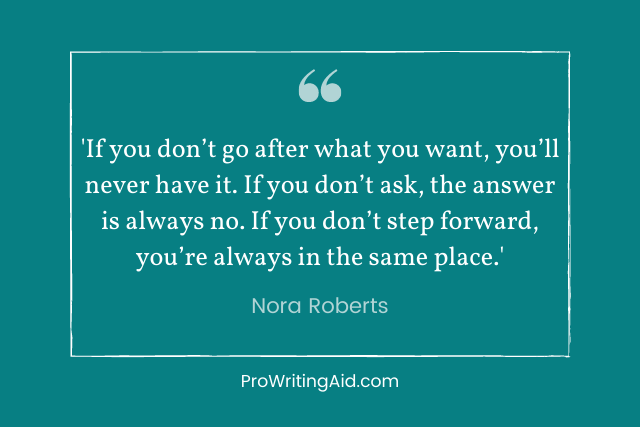
The romance genre is alive and well, my friends. More people buy romance novels than any other genre and regardless of digital or print. One of the most prolific romance writers, Nora Roberts, writes a new romance novel every 45 days. She’s not just a machine; she’s created an amazing fan base. But is that enough?
It’s interesting how a prolific woman like Nora Roberts has written dozens of books that sold over 400 million copies… but a man (ahem, cough, Nicholas Sparks) who wrote half the number of books and sold only 105 million copies has movie deals out the wazoo. But that’s another post.
In this article, let’s look at how to write romance novels like Nora Roberts.
There’s a formula—yet it’s anything but formulaic
We promise… if you want to grab the heart (and the wallet) of the romance reader, you need to stick to the formula:
- Boy meets girl
- Boy loses girl
- Boy gets girl back
How you put this structure to use is up to you, but it needs to include those elements. Now, a few more things you must do:
Character development: Your heroine and the hero must grow and change.
Backstory: Show how their past affects their relationship.
Obstacles: Throw in plenty of obstacles to their budding relationship, but make them believable.
And a couple of things to treat with caution:
Sex scenes: If this is not your forte, avoid it like the plague because it’ll be bad… terrible really.
Cliché characters: Again, avoid. Too many new writers turn to the over-done sulky, brooding hero, but no one wants to see that again.
Now let’s go further.
Your main couple must both be strong individuals
No one wants a wishy-washy hero and they certainly don’t want the damsel who must be rescued at every turn. Rather, your main couple should be strong in their own ways, yet flawed.
Your heroine, the main character, needs to be a strong woman who can take care of herself. Of course, you put her in some kind of trouble. You maybe even let the hero offer her a way out, but she must either help him solve a problem or rescue him from some trouble later on.
Most often, the heroine forces the hero out of his comfort zone. They both need to have issues they need to work through before they can be together. (Seriously, no issues = a boring story.)
Think about how you can work in vulnerability for both your main characters. This gives you the ability to dive into emotional depth and really make these characters change and grow by the end.
And just like with any other genre you consider writing, three-dimensional characters are a must.

One extra tip: readers eat up love triangles. If you’re a romance junkie, the love triangle between Scarlett O’Hara, Rhett Butler, and Ashley Wilks must continuously play on a loop in your head.
Put your own spin on a trope
Yes, romance novels have tropes, and it might behoove you to learn them. Because once you put your own spin on a trope and engage your readers, you can continue to sell them books year after year. Romance fans are loyal.
A few tried and true tropes are:
- transforming from best friends to lovers
- transforming from enemies to lovers
- one helps the other heal
- finding each other again after several years
Part of taking a trope and making it your own is using motivation successfully. Why does your main character do something, especially if it pushes the other away? Maybe he or she believes something about themselves or the other. Or perhaps they’re afraid of something happening again.
Really bring out their motives. It will be the reason a character chooses one course of action over another.
Have a romance with your writing style
Romance novels are fun. Once you've developed your characters, you get to put them in all sorts of situations that will have your readers hanging on your every word—so long as those words are well written. Romance novels get a bad rap and are often thought of a poorly written, but it's just not true. How you write is just as important as what you write. That's where ProWritingAid can help.
Beyond polishing your spelling and grammar, ProWritingAid will help you to avoid clichés, improve readability, remove distracting dialogue tags, balance your pacing and more.
Is your hero 'classically handsome'? Is he also 'classically handsome' on the next page, and then in the next chapter, or even twice in the same paragraph? When you're in writing mode, it's easy to use the same phrases repeatedly. This can be useful for getting the words down on the page, but it'll be distracting (or even boring) for your readers.

ProWritingAid's All Repeats Report will highlight all of the commonly repeated words and phrases in your document so that you can replace them with fresh ideas. If you need a little help, the Word Explorer will help you find contextually relevant synonyms that fit your scene perfectly.
Ready to give your writing the love and care it deserves?
Choose a niche
Depending on how you work, you might need to tackle this point first. If you’re a planner, you definitely must know where you fit in so you can flesh out the major details.
There are plenty of popular sub-genres of romance, such as:
- contemporary
- historical
- fantasy
- paranormal
- young adult
- religious
- erotic
If you’re a pants-er, write a bit before deciding which sub-genre your story fits in. Don’t let it discourage you if you can’t pinpoint your niche right away. Amazing writers just like you are combining sub-genres in ways that blow readers’ minds. You just do you and worry about finding your niche later.
Make the setting prominent
Actually, the setting should almost be on the level of a three-dimensional character. Romance readers want to escape, and part of escaping their everyday lives is a setting they can picture clearly in their mind’s eye. Think about how your readers can immerse themselves in your story, starting with setting.
This is easy in a contemporary romance novel because you can pick the quaint village you discovered last weekend on your drive around the countryside. But if you’re writing historical romances, you'll probably have to do a bit of research. And by a bit, we mean a lot.
Think about the wildly popular series starting with Outlander. It takes place in a settlement in the Scottish Highlands, and author Diana Gabaldon needed to nail the setting to make it believable.
The key to making the setting work for your novel is to make it immersive and believable. Consider drawing a map of your novel’s setting and posting it above your computer as you write. Or grab elements from your own hometown to add depth and character to your novel’s setting. Does your hometown have a small brewery that’s become the central locale for people to meet up? That’s a great setting to include in your novel.
Final thoughts
Your romance story must have a happy ending. It’s what all readers expect. If you don’t want to disappoint readers and alienate everyone who might buy your future books, make everything come out right in the end.
Seriously, why do you think the Hallmark Channel is so popular at Christmas time? They play lovely holiday-themed romance movies where the boy gets the girl every single time, and people eat it up.
Smart readers don’t necessarily expect "happily ever after", but they expect "happy right now". Let your reader decide if it’s forever or not and write them a happy ending they can chew on for a while.
Of course, as with any genre, make sure you tie up all loose ends at your story’s ending. Nothing turns readers off more than discovering major story threads are left dangling. Or a minor character’s story line isn’t wrapped up at the end—unless you’re setting them up for a sequel. Then it’s OK.
Let's round off with a piece of advice from the great woman herself:

Time to step forward and start writing!


